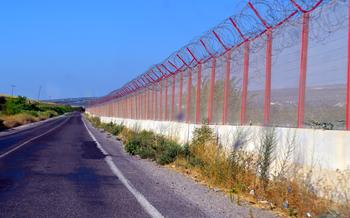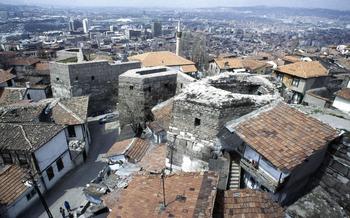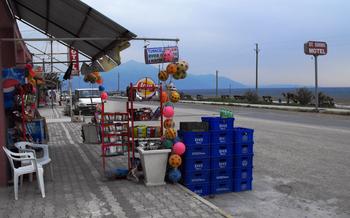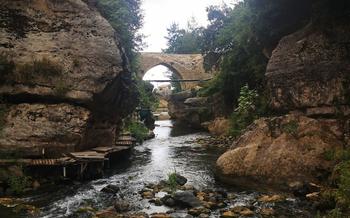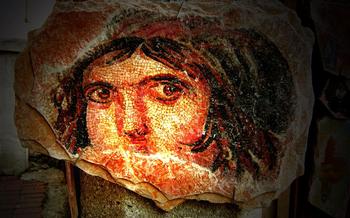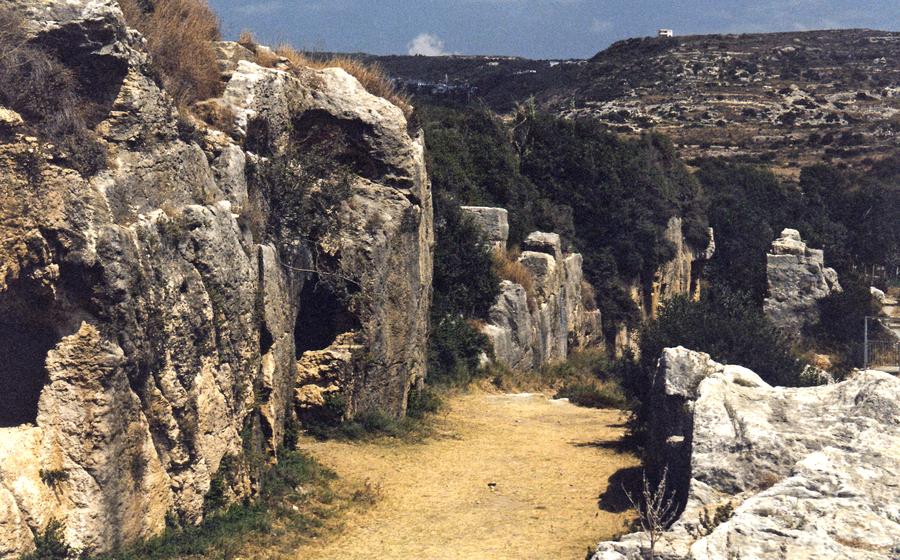
Titus Tunnel
- Unveiling the Ancient Wonder: Titus Tunnel
- Location and Accessibility
- A Journey Through Time: The History of Titus Tunnel
- Architectural Ingenuity: Exploring the Tunnel's Design
- Echoes of Legends: Myths and Folklore
- Practicalities for Visitors: Planning Your Trip
- Navigating the Tunnel: Walking Through History
- Unveiling the Secrets: Guided Tours and Exploration
- Immersive Experience: Multimedia and Interactive Displays
- A Photographic Adventure: Capturing the Beauty
- Local Treasures: Exploring Hatay's Ancient Sites
- Unforgettable Souvenirs: Shopping and Handicrafts
- Savoring Local Flavors: Hatay's Culinary Delights
- Insider Tip: Exploring Beyond the Surface
Unveiling the Ancient Wonder: Titus Tunnel
Journey back in time to the awe-inspiring Titus Tunnel, a testament to Roman engineering prowess concealed within the heart of Hatay, Turkey. Carved into the rocky hillside during the reign of Emperor Vespasian in the 1st century AD, this subterranean marvel served as a crucial passageway connecting ancient Antioch with the Mediterranean Sea.
The tunnel's significance extends beyond its practical purpose. It stands as a testament to the Romans' architectural mastery, a feat of engineering that defied the limitations of its time. Legends and myths woven around the tunnel add an ethereal dimension to its allure, captivating visitors with tales of hidden treasures and secret passages leading to lost cities.
Despite the ravages of time and natural elements, the Titus Tunnel remains remarkably well-preserved, a testament to the enduring legacy of Roman construction. Ongoing conservation efforts aim to safeguard this priceless heritage for generations to come, ensuring that the mysteries and wonders of the Titus Tunnel continue to enchant and inspire.
Location and Accessibility
The Titus Tunnel is located in the Samandağ district of Hatay, Turkey, approximately 10 kilometers from the city center. Its exact coordinates are 36°04'26"N 35°50'53"E. To reach the tunnel, visitors can take the D825 highway and follow the signs to Samandağ. There are several transportation options available, including public buses, taxis, and rental cars. Guided tours to the tunnel are also offered by local tour operators, providing a convenient and informative way to explore its history and significance. Ample parking facilities are available in the vicinity of the tunnel, ensuring a hassle-free visit for travelers arriving by car.
A Journey Through Time: The History of Titus Tunnel
Titus Tunnel, a remarkable testament to Roman engineering prowess, owes its existence to the ambitious vision of Emperor Titus Vespasianus, who reigned from 79 to 81 AD. During his brief but transformative rule, Titus initiated a series of monumental projects, including the construction of the eponymous tunnel.
The primary purpose of the Titus Tunnel was to facilitate trade and commerce between the ancient cities of Antioch and Seleucia Pieria. Antioch, a thriving metropolis and the capital of the Roman province of Syria, served as a major hub for overland trade routes. Seleucia Pieria, a bustling port city on the Mediterranean coast, acted as a gateway for maritime commerce.
The tunnel served as a vital link between these two economic powerhouses, enabling the efficient transportation of goods and commodities. By bypassing the arduous mountainous terrain, the tunnel significantly reduced travel time and costs, fostering economic growth and prosperity in the region.
Titus Tunnel also played a pivotal role in military campaigns and strategic maneuvers. In times of conflict, the tunnel provided a safe and covert passage for troops, allowing them to swiftly deploy and launch surprise attacks on enemy forces. Its strategic importance made it an integral part of the Roman military infrastructure in the region.
Throughout history, the tunnel has borne witness to the rise and fall of civilizations, witnessing countless events that shaped the destiny of the ancient world. It has endured invasions, earthquakes, and the passage of time, standing as a testament to the enduring legacy of the Roman Empire.
Archaeological excavations conducted in the vicinity of the tunnel have unearthed a treasure trove of artifacts, shedding light on the lives and culture of the people who inhabited this region during antiquity. These discoveries have provided valuable insights into the daily lives, beliefs, and customs of the ancient Romans and their contemporaries.
The Titus Tunnel is not merely a historical relic; it is a living testament to the ingenuity and perseverance of the human spirit. Its story continues to captivate and inspire visitors from around the world, who marvel at the architectural prowess and historical significance of this ancient marvel.
Architectural Ingenuity: Exploring the Tunnel's Design
The Titus Tunnel stands as a testament to the Romans' remarkable engineering prowess. Constructed using a combination of stone, brick, and mortar, the tunnel exhibits a fascinating array of structural features. Its vaulted ceiling and arched walls provide stability and strength, while niches and chambers along the sides served various purposes, such as ventilation and storage. The tunnel's intricate water management system, consisting of channels and drains, ensured that water was effectively diverted and prevented from accumulating within the structure. These ingenious engineering solutions continue to impress visitors to this day, showcasing the Romans' mastery of construction and design.
Echoes of Legends: Myths and Folklore
The Titus Tunnel is not only a historical marvel but also a source of fascination and inspiration for local legends and folklore. Stories have been passed down through generations, weaving a tapestry of mystery and intrigue around this ancient passageway.
One of the most enduring tales is that of hidden treasures buried within the tunnel's depths. Ancient maps and cryptic clues have led countless treasure hunters on a quest to uncover the riches said to be concealed beneath the stones. While no substantial treasure has been found, the allure of the unknown continues to captivate adventurers.
Another legend speaks of secret passages and lost cities connected to the tunnel. Rumor has it that hidden chambers branch off from the main passage, leading to underground labyrinths and forgotten civilizations. These tales ignite the imagination and fuel the desire to explore every nook and cranny of this enigmatic tunnel.
The Titus Tunnel also holds a special place in local traditions and beliefs. It is said that passing through the tunnel brings good fortune and protection. Locals often visit the site to seek blessings or make wishes, believing that the ancient spirits residing within the tunnel will grant their desires.
These myths and legends add a layer of enchantment to the Titus Tunnel, transforming it from a mere historical site into a realm of mystery and wonder. They inspire curiosity, exploration, and a deep appreciation for the cultural heritage embedded within this extraordinary landmark.
Practicalities for Visitors: Planning Your Trip
To fully appreciate the wonders of the Titus Tunnel, careful planning is essential. The best time to visit is during the shoulder seasons (spring and autumn) when the weather is pleasant and crowds are smaller. Summer months can be hot and crowded, while winters are mild but may experience occasional rain.
Entry to the tunnel is ticketed, with fees varying for local and international visitors. To avoid queues, consider purchasing tickets online or arriving early. The recommended duration for a visit is approximately 1-2 hours, allowing ample time to explore the tunnel at your own pace.
Basic amenities such as restrooms and a small gift shop are available on-site. However, it's advisable to bring water and snacks, as there are no food and beverage options within the tunnel. Comfortable walking shoes are a must, as the tunnel surface can be uneven. Dress appropriately for the weather, as the tunnel's interior can be cool and damp.
For those with limited mobility, accessibility options may be limited due to the tunnel's historical nature. It's advisable to contact the site authorities in advance to inquire about specific accessibility measures.
Navigating the Tunnel: Walking Through History
The Titus Tunnel stretches for an impressive distance, allowing visitors to embark on a journey through time. Its dimensions are vast, creating an awe-inspiring sense of the engineering prowess of the ancient Romans. While exploring the tunnel, be mindful of the uneven terrain and dimly lit areas. Proper footwear with good traction is essential to ensure a safe and comfortable walk. Dress in layers, as the temperature within the tunnel can fluctuate. For those with limited mobility, inquire about wheelchair accessibility options before your visit to ensure a smooth and enjoyable experience.
Unveiling the Secrets: Guided Tours and Exploration
Unveiling the enigmatic secrets of the Titus Tunnel is best done with the guidance of experienced historians and archaeologists. Guided tours provide an immersive and informative experience, shedding light on the tunnel's historical significance, architectural marvels, and fascinating legends. Experts bring the past to life, narrating tales of ancient trade routes, engineering feats, and connections to prominent historical figures.
For those seeking a deeper dive into the tunnel's mysteries, specialized tours are available, catering to enthusiasts and researchers. These tours delve into the latest archaeological discoveries, offering insights into ongoing research and conservation efforts.
To make the most of your guided tour, book in advance to secure a spot and avoid disappointment. Check tour schedules and availability online or through local tourist information centers. Whether you prefer a leisurely walk-through or an in-depth exploration, there's a tour tailored to your interests and curiosity.
Immersive Experience: Multimedia and Interactive Displays
To enhance the visitor experience, the Titus Tunnel has embraced the power of technology, providing interactive exhibits and multimedia displays that bring history to life. Virtual reality experiences allow visitors to step back in time and immerse themselves in the tunnel's ancient world, witnessing its construction and the bustling trade routes that once passed through it. Multimedia presentations and audio guides offer in-depth insights into the tunnel's significance, while augmented reality apps overlay historical reenactments onto the present, creating a truly immersive and engaging journey through the past. These interactive elements not only educate and inform but also make the experience more memorable and enjoyable for visitors of all ages.
A Photographic Adventure: Capturing the Beauty
Unleash your inner photographer and embark on a visual journey through the Titus Tunnel. Every corner, every archway, and every stone holds a story waiting to be captured. Explore the tunnel's unique angles and compositions to create stunning photographs that will transport you back in time.
The Perfect Shot:
-
Stand directly under the central arch and capture the grandeur of the tunnel's height and symmetry.
-
Frame your shot with the natural light streaming through the entrance, creating a dramatic silhouette.
-
Experiment with different perspectives, such as lying on your back and shooting upwards to accentuate the tunnel's soaring walls.
Lighting and Tripod Tips:
-
Visit during the golden hours of sunrise or sunset for the most flattering light.
-
Employ a sturdy tripod to ensure sharp and steady shots, especially in low-light conditions.
-
Use a wide-angle lens to encompass the tunnel's vastness and intricate details.
Instagram-Worthy Moments:
-
Capture the contrast between the ancient tunnel and modern-day visitors, adding a touch of human scale to your photographs.
-
Frame your shots with the surrounding landscape, including the lush greenery and distant mountains.
-
Don't forget to play with reflections in puddles or water droplets for a touch of artistic flair.
Your photographs will not only serve as beautiful mementos of your visit but also as a testament to the enduring legacy of the Titus Tunnel. So, grab your camera, embrace your creativity, and let the tunnel's timeless allure inspire your artistic vision.
Local Treasures: Exploring Hatay's Ancient Sites
Beyond the Titus Tunnel, Hatay is a treasure trove of ancient sites and historical landmarks, offering a rich tapestry of civilizations and cultures. Embark on a journey to explore these hidden gems and immerse yourself in the region's rich history.
-
St. Simeon Monastery: Perched atop a hill, this 5th-century monastery offers breathtaking views and a glimpse into the life of St. Simeon Stylites, who spent decades living atop a pillar.
-
Seleucia Pieria: Uncover the remains of this once-thriving port city, a major hub during the Roman and Byzantine periods. Admire the well-preserved mosaics and amphitheater.
-
Antakya Archaeological Museum: Delve into the region's rich history at this museum, showcasing artifacts from various civilizations, including Hittite, Assyrian, and Hellenistic periods.
-
Habib-i Neccar Mosque: Step into one of the oldest mosques in Turkey, believed to be built on the site where the Prophet Jonah (Yunus) was buried. Its unique architecture blends Islamic and Byzantine elements.
-
Harbiye Waterfalls: Escape the city's hustle and bustle at these stunning waterfalls, nestled amidst lush greenery. Enjoy a refreshing swim or simply relax and soak in the natural beauty.
Insider Tip: For a truly unique experience, visit the hidden underground city of Titus, believed to be connected to the Titus Tunnel by secret passages. Explore its chambers, tunnels, and water cisterns, offering a glimpse into Hatay's ancient secrets.
Unforgettable Souvenirs: Shopping and Handicrafts
Hatay is a treasure trove of unique souvenirs that reflect its rich history and cultural heritage. Stroll through the vibrant local markets, where you can haggle for authentic handicrafts, traditional textiles, and exquisite jewelry crafted by skilled local artisans.
- Immerse yourself in the vibrant atmosphere of the Old Bazaar, where you'll find an array of shops selling hand-woven carpets, intricately designed pottery, and colorful traditional costumes.
- Discover the art of mosaic making at one of the many workshops in Hatay, where you can create your unique mosaic piece to take home as a reminder of your trip.
- Indulge in the exquisite craftsmanship of silver jewelry at the renowned silversmiths in Hatay, where you can find intricate necklaces, bracelets, and earrings adorned with precious stones.
Remember to support local businesses and artisans by purchasing their handmade goods, contributing to the preservation of Hatay's cultural heritage while creating cherished memories of your visit.
Savoring Local Flavors: Hatay's Culinary Delights
A visit to Hatay is incomplete without indulging in its diverse and delectable cuisine. The region boasts an array of culinary treasures, blending flavors from various cultures. From traditional Turkish delicacies to Middle Eastern influences, Hatay's cuisine is a symphony of taste.
Start your culinary journey with künefe, a local favorite made from shredded dough filled with cheese and topped with a sweet syrup. Hummus and mutabbal, creamy chickpea and eggplant dips, are essential appetizers to savor with freshly baked bread.
For a taste of Hatay's unique dishes, try tepsi kebabı, a flavorful lamb and vegetable casserole baked in a clay pot. Iskenderun tava offers a delightful twist, combining lamb, peppers, and tomatoes cooked in a sizzling pan.
Vegetarians will find plenty of options, such as çökelek salatası, a refreshing salad made with yogurt, cucumber, and garlic. Zeytinyağlılar, a variety of olive oil-based dishes, showcases the region's fresh produce.
No meal in Hatay is complete without sampling the local sweet treats. Kanafeh, a delicate pastry filled with cheese and topped with syrup, is a must-try. Baklava, the quintessential Turkish dessert, is another popular choice.
For a truly immersive culinary experience, visit the traditional markets and local restaurants. Engage with the friendly locals, learn about their food traditions, and savor the authentic flavors that make Hatay's cuisine so special.
Insider Tip: Exploring Beyond the Surface
Unveiling the hidden depths of the Titus Tunnel offers a unique opportunity to explore beyond the surface. Delve into the lesser-known tales and historical anecdotes that add layers of intrigue to this ancient marvel. Discover secret spots or chambers that are not accessible to the general public, accessible only with the help of local guides or historians. Engage with locals to uncover unique perspectives and personal experiences that bring the tunnel's history to life. Enhance your visit by delving into further learning through books, documentaries, or online resources to gain a deeper understanding of this captivating historical site. Embark on a journey of discovery that unveils the hidden secrets and stories that lie beneath the surface of the Titus Tunnel.
